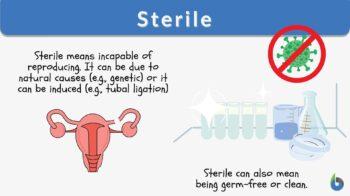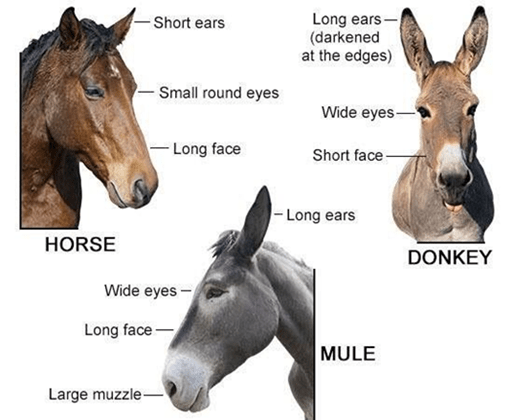
Sterile
adj.,[ˈstɛɹəl]
Definition: (1) unable to reproduce (2) clean; germ-free
Table of Contents
Sterile Definition
What does sterile mean? In reproductive biology, we can define sterile as an inability to reproduce or the unsuitability of an individual for the reproduction of progeny or offspring. It refers to a plant that is unable to germinate or produce fruit (unfruitful), such as a sterile flower that has not been fertilized.
In laboratory or biological research, the word “sterile” is used to describe an object or a procedure that is free from contamination. It means it does not have any microbe, especially ones that could have an impact on the results of the investigation or research. For example, a sterile fluid would mean it is clean and does not contain any reproductive spores or germs. A sterile procedure, in turn, means a procedure that is free from any bacteria or other microorganisms.
What is Sterile in Reproductive Medicine?
According to the medical definition of sterility, it is the inability to produce progeny (children) after having had a treatment performed such as tubal ligation, hysterectomy, or vasectomy. Tubal ligation is a technique in which a woman’s fallopian tubes are blocked or entirely removed, reducing the potential for sperm and eggs to meet. It is also known as “getting your tubes tied”.
A vasectomy is comparable to tubal ligation but it is performed on males instead of females. The tube that allows sperm to migrate out of the testicle is partially removed during the procedure. Occasionally, women will experience sterility as a result of having their uterus removed during a hysterectomy. (Fertility, 2021)
What is Sterility?
Sterility is defined as the physiological inability to reproduce sexually in a living entity whose members of its species have been formed by sexual reproduction.
The term sterile flower is sometimes used to refer to one that has to remain barren as a consequence of underdevelopment or malformation in its reproductive organs. It is also used to designate such flower that was not pollinated or fertilized for whatever cause. (Farlex, 2022)
It is a feature to use in sterile flowers for artificial selection, as they can attract the pollinating agents towards the plant. (Vedantu, 2022)
Sterility can be caused by a variety of factors. It may be a hereditary trait, as in the case of the mule, or it may be acquired through the environment, such as in the case of physical injury or disease or as in the case of radiological exposure.
Sterility vs. Infertility
Sterility is a concept frequently used as a synonym for infertility as both of them are associated with the inability to have a child. However, some references define them differently. A woman’s inability to have a biological child defines sterility whereas infertility is defined as having been pregnant but unable to carry a pregnancy to full term. Infertility affects approximately 12-15 percent of married couples worldwide. The prevalence of sterility, on the other hand, is still unknown.
Types of Sterility
According to reproductive biology, the types of sterility are as follows:
- Natural Sterility refers to a couple’s physiological incapacity to become pregnant through natural causes.
- Clinical sterility is a natural state of infertility in which the patient’s therapy will not result in the patient becoming pregnant.
- Hardship Sterility is characterized by the inability to take advantage of available therapies due to extenuating circumstances such as economic, psychological, or medical problems.
Natural sterility is a subtype of clinical sterility, while Hardship sterility is a subtype of Clinical sterility. (Wikipedia, 2022)
Another classification of sterility is primary and secondary.
- Primary sterility is when pregnancy has never been achieved.
- Secondary sterility is when no subsequent pregnancy has been achieved after the first pregnancy.
The word “sterile” means incapable of reproducing. An organism could be sterile due to genetic factors or made by undergoing procedures, such as tubal ligation. It may also be used to describe a procedure or an object that is germ-free or anything that incorporates decontamination.
How Do Species Become Sterile?
Crossbreeding and offspring production between closely related species can result in hybrid sterility in a population. They are frequently sterile because the two parents have differing numbers of chromosomes in their respective genomes. For example, in the case of the mule, an imbalance leads to offspring that are viable but not fruitful.
It is also possible to create sterility by creating a sterile environment through selective breeding, in which a selected characteristic is strongly associated with genes that are involved in sex determination or fertility.
Goats, for example, are bred to be polled (hornless). A large proportion of intersex individuals is produced among the offspring, who are often sterile as a result of this procedure.
Sterility can also be caused by genetic variations that exist within a single individual. Individuals who fall under this category are referred to as genetic mosaics. Nondisjunction, which occurs when a portion of a chromosome is missing, can result in sterility.
Another cause of sterility is XX male syndrome, which occurs when the sexual determining factor (SRY) on the Y chromosome is transferred to the X chromosome as a result of unequal crossing over. Activation of this gene causes the growth of the testicles, resulting in the individual being phenotypically masculine yet genetically feminine. (5)
Sterile Examples
Some animals, such as the mule, hinny, liger, and tigon can generate sterile offspring as a result of mating with closely related species. A mule is produced from the mating of a horse and a donkey, yet the mule is sterile over this. (Foundation, 2022)

Flowers of the Leopoldia comosa are one example of sterility. Fertile flowers are shown in the following figure, from bottom to top: open fertile flowers, buds of fertile flowers, sterile flowers. (Morales, Traveset, & Harder, 2012)

Importance and Applications of Sterile Organisms
Here are some economic applications of sterile organisms.
- The method of sterility is used for producing some types of seedless fruit, such as seedless tomatoes and seedless watermelon (though sterility is not the only available route to fruit seedlessness)
- Genetically engineered plants are prohibited from being grown in certain areas due to the use of terminator technology, which causes second-generation seeds to be sterile.
- Trap-neuter-return programs for cats are examples of biological control. Another example is the sterile insect technique, which involves releasing large numbers of sterile insects into the environment to compete with fertile insects for food and mates, resulting in a reduction in the population size of subsequent generations. This technique can be used to combat epidemics spread by insect vectors such as dengue fever in mosquitoes.
Sterilization
We mentioned above that another meaning of “sterile” is being free from microbes or any viable organism. The physical process of making an object sterile is called sterilization. Petri dish, culture media, and inoculating loop, for example, need to be sterile to make sure that all microorganisms are destroyed and would not have an effect on the procedure and/or findings. This is usually done by subjecting them to high heat and/or pressure (e.g, by autoclaving glassware and media and heating inoculating loop over the flame of a bunsen burner).
Try to answer the quiz below to check what you have learned so far about sterile.
Reference
- Farlex. (2022). Sterile Flower. Retrieved 18 March, 2022, from https://encyclopedia2.thefreedictionary.com/Sterile+Flower
- “Sterility”. (2021). Retrieved 18 March, 2022, from https://ormfertility.com/fertility/causes-infertility/what-is-the-difference-between-sterility-and-infertility/
- Ck12.org. (2022). biological species. Retrieved 18 Mach, 2022, from https://www.ck12.org/book/ck-12-biology-advanced-concepts/section/10.37/
- Morales, C. L., Traveset, A., & Harder, L. D. (2012). Sterile flowers increase pollinator attraction and promote female success in the Mediterranean herb Leopoldia comosa. Annals of Botany, 111(1), 103-111. doi: 10.1093/aob/mcs243
- Vedantu. (2022). sterile flower. Retrieved 18 March, 2022, from https://www.vedantu.com/question-answer/what-is-a-sterile-flower-class-11-biology-cbse-5f47702255e8473a85c47843
©BiologyOnline.com. Content provided and moderated by Biology Online Editors.





